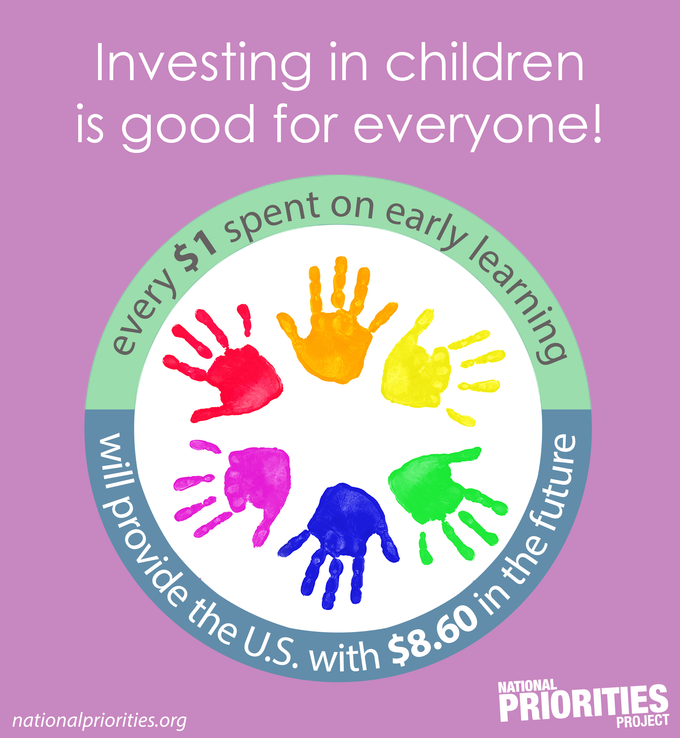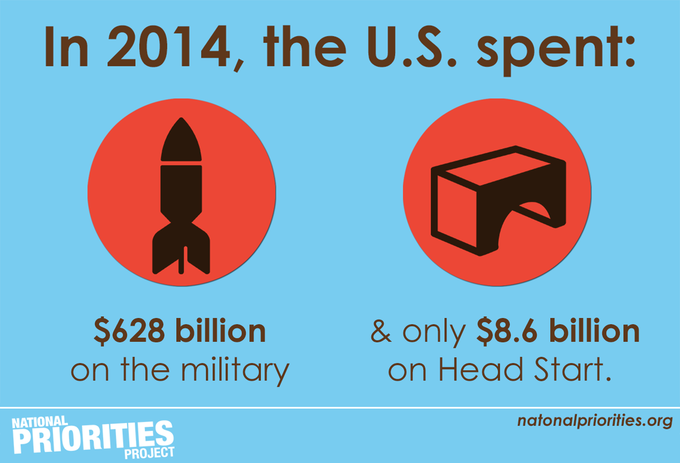Inequality Showdown: Early Childhood Education
Nov. 9, 2015 - Download PDF Version

Why Preschool?
Child care costs for a 4-year-old range from $344 per month in rural South Carolina to $1,472 per month in Washington, D.C.[1] The current lack of affordable child care means fewer options for families to get ahead.
Preschool provides benefits for all children, but is especially important for kids in low-income families. Being poor takes a real toll on kids, but those who attend a quality preschool are more likely to graduate from high school, earn more as adults, and are less likely to become teen parents, serve jail or prison time, or need government assistance like welfare or food stamps.[2] Every kid deserves a good start in life.
Getting these results requires high quality preschool programs. That means well-educated, well-paid teachers and thoughtful, comprehensive programs that support the whole child. It’s not cheap. But it’s worth it, and we can afford it. It’s time to get serious about what families need in the 21st century: it’s time for us to recognize that preschool is essential for our kids, our families, and our economy.
How does the federal government support early childhood education?
Three major federal programs that support early childhood education are Head Start, Child Care and Development Block Grants, and Child care tax credits.
- Head Start is free to participants and provides education, health and social services. The program has served 32 million children since 1965, including nearly 1 million children and families in 2014.
- Child Care and Development Block Grants send federal money to states to subsidize child care for low-income families. Each month, nearly 1.5 million children receive this subsidized child care.
- Child care tax credits reduce the amount of income tax that families owe, and can result in a bigger tax refund. Child care tax credits are taken by over 6 million taxpayers. The average tax savings for families is about $540 a year.[3]
How much does the federal government invest in early education?
Head Start received about $8.6 billion in 2014.[4] The average taxpayer contributes about $44 a year for Head Start. Child Care and Development Block grants received $5.3 billion in 2014.[5]
To put that in context, in 2014, our federal government spent $628 billion on the Pentagon and related costs, including $19 billion for nuclear weapons and related costs: more than twice as much as we invested in Head Start.

Focus on Head Start: Who benefits?
Head Start is the biggest federal early childhood education program. Compared to the whole population, children in Head Start are more likely to be Latino or African American, to speak Spanish at home, to have a disability, or to experience homelessness.
- 29% of families and children in Head Start are African American.
- 38% of families and children in Head Start are Hispanic or Latino.
- 25% of families and children in Head Start speak primarily Spanish at home.
- 12% of children in Head Start have disabilities.
- 45,000 Head Start families experienced homelessness – almost 1 in 20 Head Start families.
- Of every $14 invested in Head Start, $1 goes to American Indian, Alaska Native and Migrant kids.[6]
Who needs better access to early childhood education?
Everyone. Only four in ten 4-year olds are in publicly funded preschool programs. But some groups have less access to quality preschool than others. Latinos have the lowest preschool participation rates of any major ethnicity or race. African American children are more likely to attend low-quality preschool programs than children of other races.
Demand for federal funding is also high. In 2014, 35 states applied for federal funding through a new program called Preschool Development Grants, but only 18 were funded. [7]
What are the economic benefits of early education?
Early learning provides society with a return on investment of $8.60 for every $1 spent. About half of that benefit comes from kids who attend preschool earning higher incomes as adults.[8]
Are there proposals to invest more in early childhood education?
Yes. President Obama’s proposed budget and the Congressional Progressive Caucus People’s Budget both propose spending $66 billion over 10 years for federal-state public preschool.[9]
Can we afford it?
The president’s proposal would pay for expanded public preschool by increasing taxes on tobacco. There are other possibilities, too: cutting unnecessary Pentagon spending by 2% could more than double Head Start funding. Or, if taxpayers with incomes of more than $500,000 paid between 0.1% and 1.4% more in income tax (with the highest increases for incomes above $10 million), we could cover the cost of the president’s Preschool for All proposal.[10]
[1] Economic Policy Institute. High quality child care is out of reach for working families.
[2] Social Programs that Work: Perry Preschool.
[3] IRS Individual Income Tax Statistics, Historical Table 2, 2013.
[4] Head Start Program Facts, Fiscal Year 2014.
[6] Head Start Program Facts, Fiscal Year 2014.
[7] U.S. Department of Education. A Matter of Equity: Preschool in America.
[8] White House Council of Economic Advisors. The Economics of Early Childhood Investments.
[9] National Priorities Project, Competing Visions.
[10] IRS Individual Statistical Table 1.1, 2013.